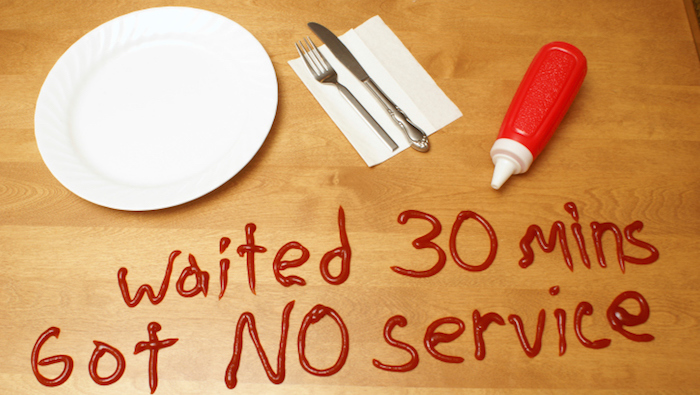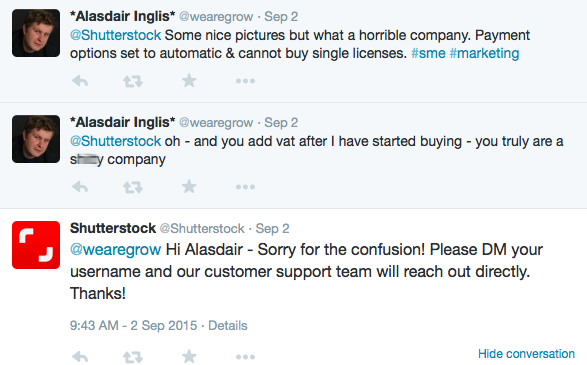Every business hopes for glowing reviews from its customers, but there’s always a Debbie Downer in the bunch. Every business gets negative reviews. Considering the anonymity of social media, it’s the perfect spot to spout off.
Most dissatisfied customers don’t complain. Research suggests that just 4% of unhappy customers share their concerns. That might sound like a good thing. After all, who wants to hear negative comments about their business? But negative reviews shouldn’t scare you. Here’s why:
- Negative feedback can reveal flaws in your system that can be fixed.
- Negative feedback gives you a chance to listen to your customers and improve your business.
- Customers that leave negative reviews not only believe it’s worth their time to share their concerns, but they also believe a solution can be found.
- Research suggests that complaining customers are more likely to revisit your business, as opposed to silently unhappy customers who take their business elsewhere without ever telling you why.
- Some dissatisfied customers can turn into loyal customers, or even brand advocates, if the complaint is handled well. When companies respond to negative comments, 33% of complainers turned around and posted a positive review, and 34% deleted the negative review themselves, according to a Harris survey.
When The Haters unleash their opinions, don’t panic. Just follow these tips to make sure you handle negative reviews the right way.
Don’t delete or ignore negative reviews
If a particular comment really gets your blood boiling, you might be tempted to delete it, or even worse, ignore it. If you delete the comment, it looks like you have something to hide. If you ignore it, it looks like you don’t care.
Respond quickly
Don’t let a negative comment linger, it will stink up the place faster than moldy leftovers in your fridge.
Time matters in the world of social media. People expect immediate answers, so monitor your sites frequently and respond to negative comments as soon as possible.
When a customer complains about technical problems with food-ordering website, Seamless, the company is quick to respond. Take a look at the example below. The company responds in less than 10 minutes to the complaint.
Ten minutes is fast, but responding within an hour or two is okay.
Kill them with kindness
Your gut reaction to a negative review might be a slew of not-so-nice words. Take a moment, compose yourself and prepare a response that’s the exact opposite of your initial response. Kindness is your best solution. A poor response can bubble into a viral mess.
A restaurant in Boston went with a knee-jerk reaction to a poor review. The chef actually swore at the customer. Yikes! Needless to say, this is an example of what not to do:
Explain why
Sometimes customers lack information, get frustrated and take it out on your social media site. If you can, explain why problems occur. For example, a customer might not know that your coffee shop is backed up because of a power outage. If customers comment about their wait time, explain why it happened.
When a customer complained about an additional charge at Subway, the sub shop explained that franchise owners can tack on fees. The company encouraged the customer to email a formal complaint. Explanations like this can help you retain unhappy customers.
Say you’re sorry
An apology goes a long way to ease customer relationships. Complainers want to be heard; so apologizing is the best medicine for Cranky Customer Syndrome. Even if something happens that’s out of your control, you should still apologize.
In the example below, a customer complains about the payment options on stock photo site, Shutterstock. The customer even uses profanity in his second complaint, but Shutterstock still apologizes for the confusion.
Move the conversation offline
After you address the complaint publically, encourage the customer to reach out privately. The Shutterstock example above does exactly that by encouraging the user to send a direct message to the company so a customer service representative can follow up. Twitter recently nixed their 140 character count limit for direct messages, which allows for more dialogue and conversations with customers in a less public space.
Handling negative feedback shouldn’t keep you up at night. Yes, poor reviews are harsh to hear, but a lot of customers change their tune when a complaint is handled well.
How will you handle your next negative review? Share your thoughts in the comment section below.











Leave a Comment